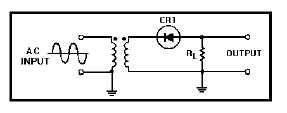8
Figure 1C
IN ANSWERING QUESTIONS 1-56 AND 1-57,
REFER TO FIGURE 1-C.
1-56. What type of circuit is shown in figure
1-C?
1. Positive half-wave rectifier
2. Negative half-wave rectifier
3. Full-wave rectifier
4. Clipper
1-57. With the input shown in figure 1-C, which
of the following outputs would be correct?
1.
2.
3.
4.
1-58. If the input frequency to a half-wave
rectifier is 120 hertz, what is the output
frequency of the rectified dc?
1. 30 pps
2. 60 pps
3. 120 pps
4. 240 pps
1-59. Why are the units (plates) of the metallic
rectifier stacked?
1. To dissipate heat
2. To be used in more than one circuit
3. To prevent inverse voltage breakdown
4. To handle high current applications
1-60. Which of the following types of rectifiers
replaces the bulky selenium rectifier?
1. Copper-oxide rectifier
2. Half-wave rectifier
3. Metallic rectifier
4. Silicon rectifier
1-61. Signal diodes are used for which of the
following purposes?
1. As mixers
2. As switches
3. As detectors
4. Each of the above
1-62. What type of bias makes a diode act as an
open switch?
1. Direct
2. Reverse
3. Forward
4. Switching
1-63. A standard specification sheet for a diode
contains which of the following
information?
1. A brief description of the diode
2. Major application of the diode
3. Special features of the diode
4. All of the above











